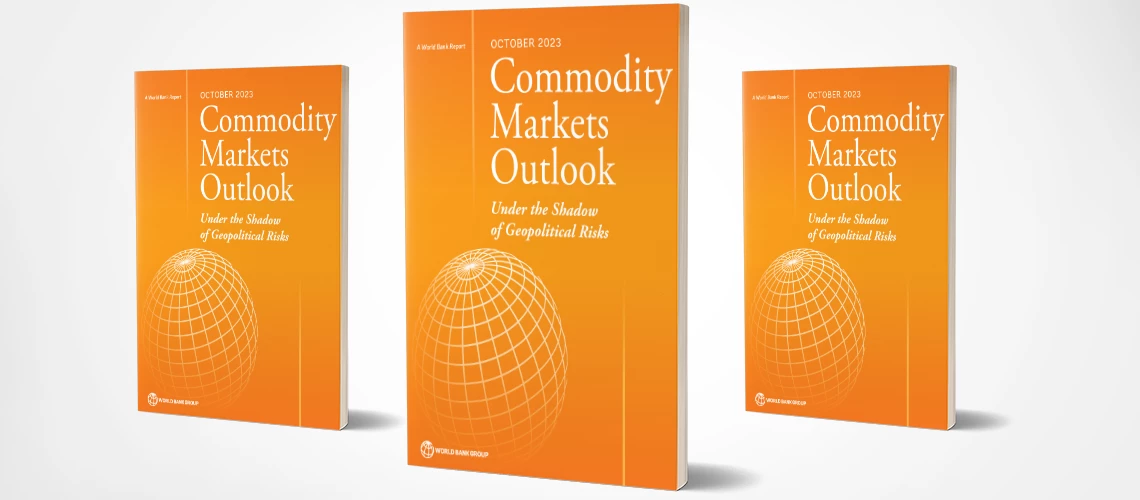 Commodity Markets Outook October 2023
Commodity Markets Outook October 2023
The World Bank commodity price index is expected to fall 4 percent in 2024, following a projected decline of nearly 24 percent in 2023, the sharpest drop since the pandemic. Energy prices are expected to decline by almost 5 percent in 2024 and remain relatively stable in 2025. Agriculture prices are expected to decline over the forecast period, while metal prices are set to fall in 2024 but see a 6 percent uptick in 2025. The forecasts assume that the conflict in the Middle East will have a limited impact on commodity prices, though geopolitical risks remain high. Disappointing global growth presents a downside risk, especially for industrial commodities. Additional trade restrictions and intensification of El Niño could push food prices higher.
Commodity prices rose 5 percent in the third quarter of 2023, driven by a surge in oil prices. The start of the conflict in the Middle East in early October led to an initial uptick in prices, though the impact so far has been small: by end-October, commodity prices remained 29 percent below their June 2022 peak. The decline reflects a combination of slowing economic activity impacting metal prices and favorable weather conditions boosting agriculture yields. Nonetheless, prices of most commodities are higher than their 2015-19 average.
Oil prices rose from $72 to above $90 by the end of the third quarter. The surge was driven mainly by cuts from the OPEC+ group, especially Saudi Arabia, whose output in 2023Q4 is expected to be nearly 2 mb/d lower compared to a year earlier. The price of Urals, the Russian benchmark, has increased even faster and is significantly above the price cap set by G7 countries. Although Brent oil prices experienced considerable volatility following the onset of the Middle East conflict in early October, they have since declined to $83/bbl by end-November, ahead of the monthly OPEC meeting, below pre-conflict levels. Oil prices are projected to average $84/bbl in 2023 (implying a $90/bbl average for 2023Q4), down from $100/bbl in 2022. In 2024, they are expected to average $81/bbl in response to slowing demand and improved non-OPEC supplies and stay around this level in 2025.
Natural gas prices in Europe remain elevated and sensitive to disruptions at LNG terminals. Prices dropped 5 percent in 2023Q3 from the previous quarter, following steep declines earlier in the year amid weak liquefied natural gas (LNG) imports by China and the EU’s orderly replacement of Russian pipeline gas by LNG (currently over 95 percent of full capacity). Prices peaked in early October after the shutdown of a gas field off the coast of Israel, an explosion at a Baltic Sea interconnector, and concerns of conflict escalation in the Middle East. Following a projected 68 percent decline in 2023, European natural gas prices are expected to decline an additional 4 percent in 2024, owing to slower demand. U.S. natural gas and LNG prices are also expected to decline in 2024—by 20 and 7 percent, respectively.
Supply conditions for agriculture and food commodities have improved, but risks remain. Agricultural prices have been relatively stable during the past 12 months, evidenced by a modest drop of 2 percent in 2023Q3 and a 3 percent decrease from a year ago. Food prices experienced larger declines over the past year (-6 percent). Factors like the non-renewal of the Black Sea Grain Initiative, India’s export ban of non-basmati rice, and intensification of El Niño have been offset by improved supply prospects for key food commodities, including maize, soybeans, and wheat. Following a projected 7 percent decline in 2023, agricultural prices are expected to fall by a further 2 percent in 2024 and 2025, owing to ample supplies.
Despite ample food supplies, food insecurity remains a significant concern. Food insecurity continues to be a major threat in many countries, despite ample food supplies and declining food price inflation. Following several years of decline up to 2015, food insecurity has been rising, reaching over 900 million people in 2022. The recent conflict in the Middle East, which came on the heels of the Ukraine war, is likely to further exacerbate food insecurity. For instance, even before this latest conflict, 53 percent of the population in Gaza was already food insecure.
Metal prices have weakened amid demand concerns. Metal prices fell 2 percent in 2023Q3 relative to the previous quarter and are now at approximately the same level as a year ago. Weakness in China’s heavy industry and housing construction sectors has been offset by resilient demand in the manufacturing of metals-intensive renewable energy products, amid ample metal supply. Following a projected decline of 12 percent in 2023, base metal prices are expected to fall 5 percent in 2024 due to slowing demand. However, they are expected to recover in 2025 as global activity improves and the demand for metals in renewable energy technologies accelerates.
Demand for some critical minerals is soaring. With electric vehicles now comprising one in five cars sold globally, the demand for minerals used in electric vehicle and battery production, such as cobalt, lithium, and molybdenum, will continue to soar. In the short term, they have followed the downward trend in base metals prices, although prices remain volatile due to the stratified and concentrated nature of mineral markets. Firming global growth, along with policies to expand renewable energy infrastructure, are expected to underpin a rebound in metal and mineral prices in 2025. Global investment in clean energy infrastructure has grown by almost 28 percent between 2021 and 2023 and continues to rise rapidly, propelling a demand surge for copper, lithium, and nickel.




Join the Conversation